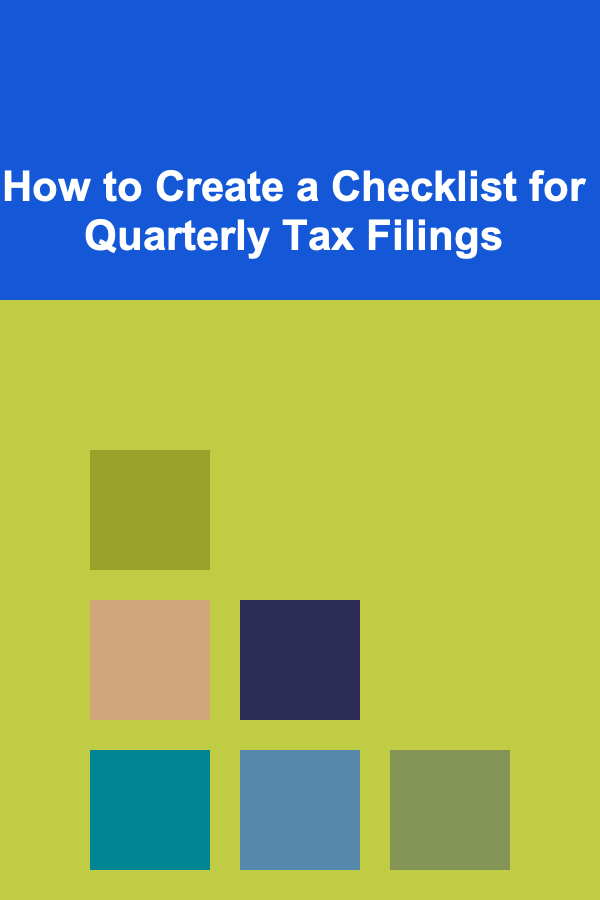
How to Create a Checklist for Quarterly Tax Filings
ebook include PDF & Audio bundle (Micro Guide)
$12.99$8.99
Limited Time Offer! Order within the next:

Quarterly tax filings are a crucial part of managing your finances as a business owner, freelancer, or contractor. Missing deadlines or failing to file correctly can result in penalties, interest, and even more serious tax issues. Creating a checklist for quarterly tax filings can simplify the process, ensuring that you stay on top of deadlines and avoid costly mistakes.
In this actionable guide, we'll break down how to create a comprehensive quarterly tax filing checklist. From understanding your tax responsibilities to tracking essential deadlines, we will cover the steps necessary to build an effective system for managing your quarterly tax filings.
Understand Your Tax Obligations
Before you start creating your checklist, it's important to fully understand your tax obligations. Different businesses and individuals may have varying tax responsibilities depending on their income, business structure, and location. Here are the key elements to keep in mind:
Federal Tax Requirements
- Self-Employment Tax: If you're self-employed, you must pay self-employment tax, which covers Social Security and Medicare. This applies to freelancers, independent contractors, and small business owners who don't have an employer withholding taxes.
- Estimated Taxes: If you expect to owe $1,000 or more in taxes for the year (after subtracting withholding and refundable credits), you're generally required to make estimated quarterly tax payments to the IRS.
- Income Tax: Depending on your income level, you may need to pay federal income tax in addition to self-employment tax. This applies to both individuals and businesses.
- Filing Forms: Depending on your situation, you may need to file Form 1040-ES (for individuals) or Form 1120-W (for corporations) to calculate and make estimated tax payments.
State and Local Tax Requirements
Each state (and sometimes even local jurisdictions) has its own tax rules. Some states require estimated tax payments, while others do not. Make sure to familiarize yourself with your state's requirements and deadlines. You may need to file state income tax, state sales tax, or other forms depending on the nature of your business and location.
Actionable Tip:
Consult a tax professional or use tax software to better understand your specific tax obligations, including any deductions or credits you may be eligible for, based on your situation.
Set Up a Tax Filing System
Organizing your financial information is essential to ensure that your quarterly tax filings are accurate and timely. A tax filing system will allow you to track all necessary documents and make the filing process as smooth as possible.
Document Organization
- Income Documentation: Keep track of all sources of income, including invoices, receipts, and bank statements. This will help you calculate your total earnings and estimate the taxes you owe.
- Business Expenses: Keep detailed records of business-related expenses, such as rent, supplies, utilities, marketing, and travel. This information is essential for calculating deductions.
- Tax Forms: Maintain organized records of your previous filings, W-2s, 1099s, and other documents that pertain to your taxes.
- Receipts and Invoices: Regularly store and categorize your receipts and invoices to ensure you can account for every business expense.
- Payroll Records (if applicable): If you have employees, keep accurate payroll records, including pay stubs, tax withholdings, and benefits paid.
Actionable Tip:
Use a cloud-based accounting system like QuickBooks, Xero, or FreshBooks to automate tracking and organizing your documents. This will make it easier to access your financial information and generate reports for tax filing.
Know Your Tax Deadlines
A critical part of your checklist is to track the important deadlines for tax filings. Missing a deadline can result in penalties, interest, and potentially an audit. The IRS sets specific deadlines for estimated tax payments, and each state may have its own dates as well.
Federal Estimated Tax Deadlines
For most taxpayers, the IRS requires quarterly estimated tax payments to be made on the following dates:
- First Quarter (January 1 -- March 31): Payment due April 15
- Second Quarter (April 1 -- May 31): Payment due June 15
- Third Quarter (June 1 -- August 31): Payment due September 15
- Fourth Quarter (September 1 -- December 31): Payment due January 15 (of the following year)
State and Local Tax Deadlines
State and local tax deadlines vary widely, so make sure to check with your state's department of revenue or local tax authority. These deadlines may align with the federal deadlines or be slightly different.
Actionable Tip:
Use a digital calendar (Google Calendar, Outlook, etc.) to set reminders for each tax filing deadline. You can even set reminders a few days before each deadline to ensure you have enough time to prepare.
Calculate Your Estimated Taxes
Once you understand your tax obligations and have organized your financial documents, you need to calculate your estimated taxes for the quarter. This involves determining your taxable income, applying any deductions or credits, and calculating how much you owe.
Income Calculation
Start by calculating your total income for the quarter. This includes income from all sources such as:
- Business revenue
- Investment income
- Passive income (rents, royalties, dividends)
- Other sources of income
Deductions and Credits
After calculating your income, consider deductions and credits you are eligible for. Common deductions for business owners and freelancers include:
- Home office expenses
- Mileage or vehicle expenses
- Health insurance premiums
- Business supplies and equipment
- Depreciation of assets
Estimated Tax Calculation
Once you have your net taxable income, you can calculate your estimated tax payments. This is typically done by applying the appropriate tax rate to your taxable income. Keep in mind that both federal and state taxes will apply, and that the self-employment tax is also a part of the calculation.
Actionable Tip:
You can use tax calculators or tax software (like TurboTax or TaxSlayer) to estimate your quarterly taxes. These tools help you calculate your tax liabilities and provide a clearer picture of how much you owe.
Make Your Quarterly Tax Payment
After calculating your estimated taxes, the next step is to make your payment. Both federal and state taxes can usually be paid online. Here's how you can proceed:
Federal Payments
- IRS Direct Pay: The IRS offers a free online tool to make direct payments from your bank account. This can be done for individual or business taxes.
- Electronic Federal Tax Payment System (EFTPS): If you're making regular payments, you may want to set up an EFTPS account. This system allows you to schedule and make payments online.
State Payments
Most states offer similar online payment portals. Check your state's revenue department website for instructions on how to make your payment.
Actionable Tip:
Pay your estimated taxes as soon as possible after calculating them. Set up automatic payments or schedule recurring reminders to avoid missing payments.
Review and Adjust Your Payments
After each quarter, review your tax situation to determine whether your estimated payments were accurate. If your income or expenses have changed significantly, you may need to adjust your estimated tax payments for the next quarter.
Common Situations for Adjustments:
- Income Fluctuations: If your income increased or decreased significantly, you may owe more or less in taxes than initially estimated.
- Changes in Deductions or Credits: If you qualify for new deductions or credits, your payments may need to be adjusted.
- Overpayments/Underpayments: Review your previous tax filings to ensure you didn't overpay or underpay your taxes. If you overpaid, you may receive a refund, but if you underpaid, you may owe penalties.
Actionable Tip:
Keep track of any major life events, such as moving to a new state, getting married, or changing your business structure, as these can impact your tax obligations and require payment adjustments.
Conclusion
Creating a quarterly tax filing checklist is essential for staying organized and ensuring that you meet your tax obligations on time. By understanding your tax responsibilities, setting up a filing system, tracking important deadlines, calculating your estimated taxes, and reviewing your payments, you can make quarterly tax filing less stressful and more efficient.
Remember, taxes are an ongoing process, and staying on top of your filings will save you from last-minute scrambling and penalties. Keep accurate records, stay informed about deadlines, and adjust your payments as needed to ensure you're always prepared for the next tax season.

How to Build Multiple Income Streams to Improve Financial Stability
Read More
How to Coordinate Group Workouts with Organized Spaces
Read More
How to Manage Your Home Renovation Budget Efficiently
Read More
How to Stage Your Home to Stand Out in a Competitive Market
Read More
How to Use Indoor Plants for Holiday Decorations
Read More
The Ultimate Guide to Creating a Mobile App
Read MoreOther Products

How to Build Multiple Income Streams to Improve Financial Stability
Read More
How to Coordinate Group Workouts with Organized Spaces
Read More
How to Manage Your Home Renovation Budget Efficiently
Read More
How to Stage Your Home to Stand Out in a Competitive Market
Read More
How to Use Indoor Plants for Holiday Decorations
Read More